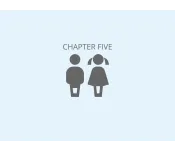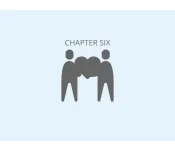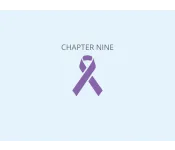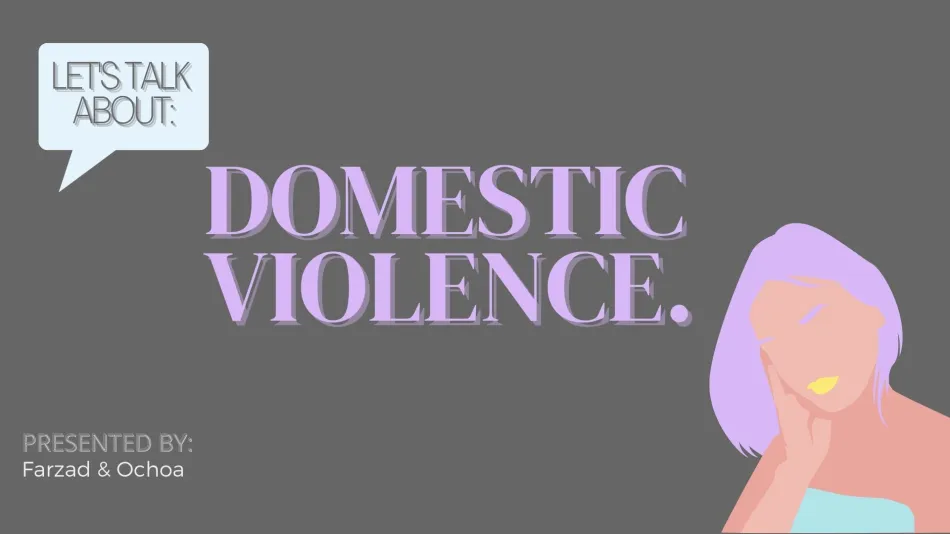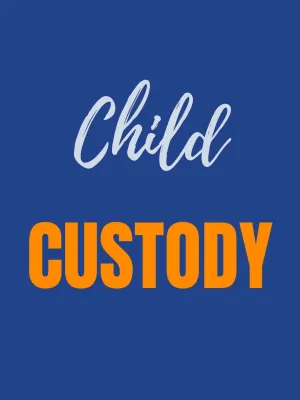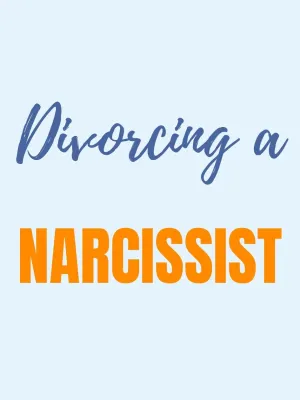Domestic Violence Definition, Statistics, Awareness, Law & Advocacy
Our Guide to Freedom from Domestic Violence is for victims, survivors, advocates, writers and knowledge seekers
This domestic violence guide will forever change the way you look at domestic violence
Our Guide to Freedom from Domestic Violence is a game-changer. It will help you gain incredible knowledge and awareness about domestic violence in California and the United States.
We discuss domestic violence's definition, statistics, bring you awareness, show you how a victim can escape the violence and become a survivor, the serious consequences to a perpetrator and so much more.
We wrote this comprehensive guide for five groups
- Domestic violence victims and survivors,
- Those individuals who want to help victims of domestic violence,
- Individuals and companies, including the media, who write about domestic violence and need a citable resource,
- Those who volunteer their time at shelters, clinics and non-profits, and
- Those men and women who want to learn more about domestic violence.
This domestic violence guide is not just a guide on domestic violence within family law, criminal law and civil law
This domestic violence guide provides you with:
- A list of resources available to domestic violence victims and survivors of all demographics,
- Tips for individuals who want to help domestic violence victims,
- Domestic violence statistics that will inform and may surprise you, and
- Domestic violence coverage in the news and media.
Domestic violence resource pamphlet
Separate from this guide, we created a digital domestic violence resource pamphlet for victims and survivors. Click on the image below to access this PDF document.
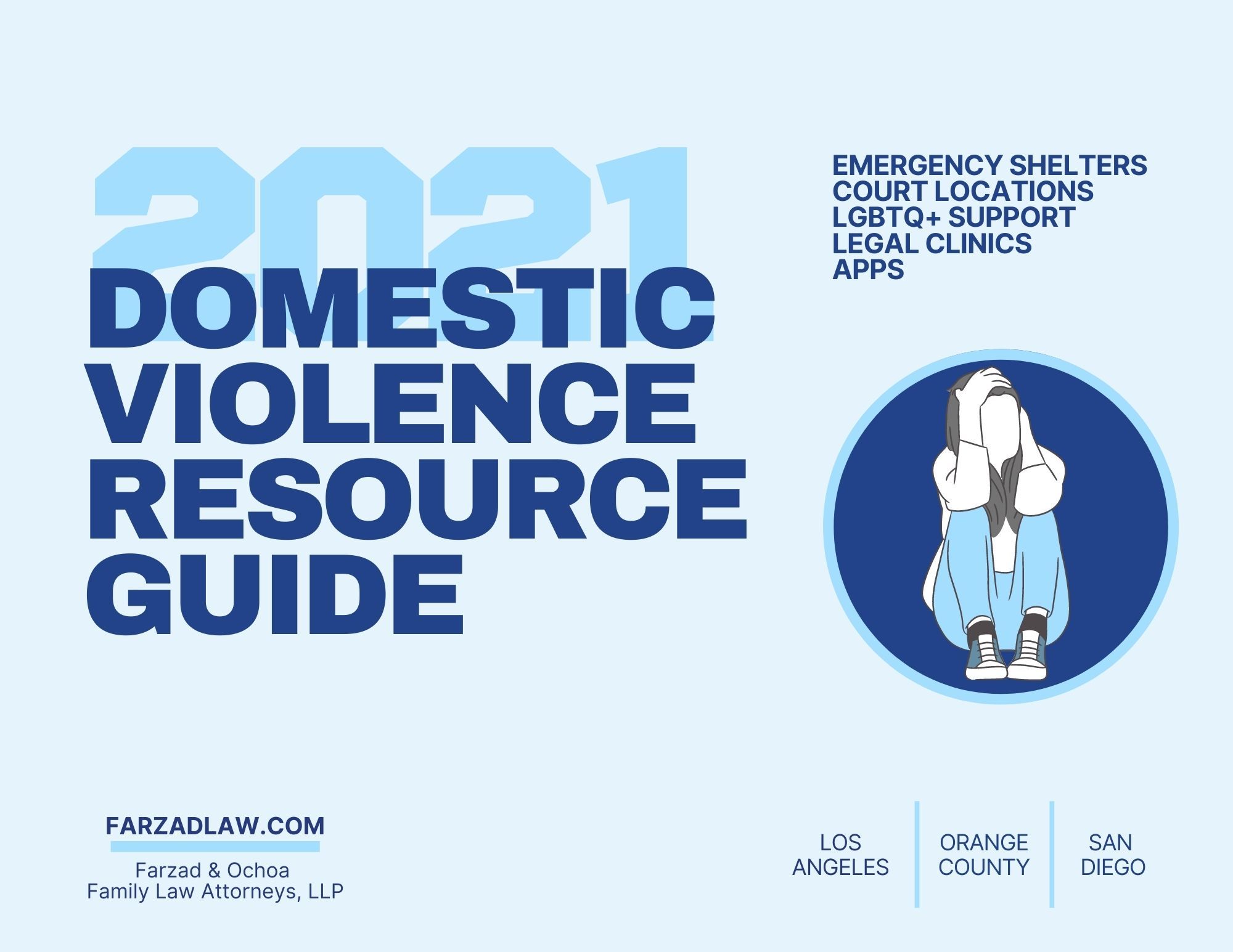
Our goal in this guide was to cover nearly every aspect of domestic violence
We want victims and survivors, advocates, writers and everyone else to have a terrific resource.
Victims of domestic violence remain victims if they do not have options for a better life.
You can help by spreading the word about the resources available to domestic violence victims, dedicating your time at local shelters or donating money to non-profit domestic violence groups.
One of the easiest ways to contribute is to share what you learned with the victims. That may be as simple as providing them with a link to this guide and the other resources we listed.
Our California family law firm is proud of our pro-bono volunteer work on behalf of domestic violence victims. Someone has to help the victims and their children. We do. You can too.
- B. Robert Farzad
Domestic Violence Chapters
Please use the table of contents to navigate our domestic violence guide.
Each heading topic below is a link and it will take you to a chapter and section of this guide.
We also created a domestic violence video as an introduction to and summary of this guide. You will see the video after the table of contents. We hope you enjoy the video as a complement with the guide.
This domestic violence guide is not legal advice, nor is it a substitute for legal advice.
Before we dive into this incredible domestic violence guide, here is a video that summarizes what you are about to read. If you need a transcript of the video, here it is: transcript.
Below the English video is a Spanish version of the same video and here is the Spanish version transcript.
Chapter One
What is Domestic Violence?
What Are the Types of Domestic Violence?
What Are the Signs of Domestic Violence?
What is domestic violence?
Domestic violence is abuse. That abuse may be physical, verbal and/or psychological. The intent is the same - to injure or degrade a victim.

Domestic violence ranges in form and severity. It may be covert. Examples include neglect or manipulation. Domestic violence may be overt, such as physical assault or verbal abuse.
Most abusers use domestic violence to dominate and control a victim.
Many victims do not or cannot report their abuse. The silence surrounding domestic violence enables abusers to continue without consequence.
Legal definition of domestic violence and abuse in California
California Family Code Section 6203 states domestic violence includes the following.
- To intentionally or recklessly cause or attempt to cause bodily injury.
- Sexual assault.
- To place a person in reasonable apprehension of imminent serious bodily injury to that person or to another.
- To engage in any behavior that has been
or could be enjoined under Section
6320.
Abuse is not limited to the actual infliction of physical injury or assault.
However, Family Code Section 6320 takes that much further.
Family Code 6320 expands the definition of domestic violence
Family Code 6320 has five parts to it.
This is generally what it takes to get a domestic violence restraining order in California
(a) The court may issue an ex parte order enjoining a party from molesting, attacking, striking, stalking, threatening, sexually assaulting, battering, credibly impersonating as described in Section 528.5 of the Penal Code, falsely personating as described in Section 529 of the Penal Code, harassing, telephoning, including, but not limited to, making annoying telephone calls as described in Section 653m of the Penal Code, destroying personal property, contacting, either directly or indirectly, by mail or otherwise, coming within a specified distance of, or disturbing the peace of the other party, and, in the discretion of the court, on a showing of good cause, of other named family or household members.
Part two takes it further and includes protection of animals
(b) On a showing of good cause, the court may include in a protective order a grant to the petitioner of the exclusive care, possession, or control of any animal owned, possessed, leased, kept, or held by either the petitioner or the respondent or a minor child residing in the residence or household of either the petitioner or the respondent. The court may order the respondent to stay away from the animal and forbid the respondent from taking, transferring, encumbering, concealing, molesting, attacking, striking, threatening, harming, or otherwise disposing of the animal.
What is intentionally or recklessly disturbing the peace of another for it to become domestic violence?
(c) As used in this subdivision (a), "disturbing the peace of the other party" refers to conduct that, based on the totality of the circumstances, destroys the mental or emotional calm of the other party. This conduct may be committed directly or indirectly, including through the use of a third party, and by any method or through any means including, but not limited to, telephone, online accounts, text messages, internet-connected devices, or other electronic technologies. This conduct includes, but is not limited to, coercive control, which is a pattern of behavior that in purpose or effect unreasonably interferes with a person's free will and personal liberty. Examples of coercive control include, but are not limited to, unreasonably engaging in any of the following:
And the following is the game-changer in California that is part of coercive control
This is what comes after the above in the code.
(1) Isolating the other party from friends, relatives, or other sources of support.
(2) Depriving the other party of basic necessities.
(3) Controlling, regulating, or monitoring the other party's movements, communications, daily behavior, finances, economic resources, or access to services.
(4) Compelling the other party by force, threat of force, or intimidation, including threats based on actual or suspected immigration status, to engage in conduct from which the other party has a right to abstain or to abstain from conduct in which the other party has a right to engage.
California law also states what it listed above is not the limits of remedies available
(d) This section does not limit any remedies available under this act or any other provision of law.
Domestic violence protections apply to specific relationships
California Family Code Section 6211 states that domestic violence is abuse perpetrated against:
- A spouse or former spouse.
- A cohabitant or former cohabitant, as
defined in Section
6209.
- A person with whom the respondent is having or has had a dating or engagement relationship.
- A person with whom the respondent has had
a child, where the presumption applies that the male parent is the father of
the child of the female parent under the Uniform Parentage Act
(Part 3 (commencing with Section 7600) of Division 12).
- A child of a party or a child who is the subject of an action under the Uniform Parentage Act, where the presumption applies that the male parent is the father of the child to be protected.
- Any other person related by consanguinity or affinity within the second degree.
Types of domestic violence
Domestic violence can involve various parties, tactics, and consequences. Abusers dominate and control a victim through abuse.
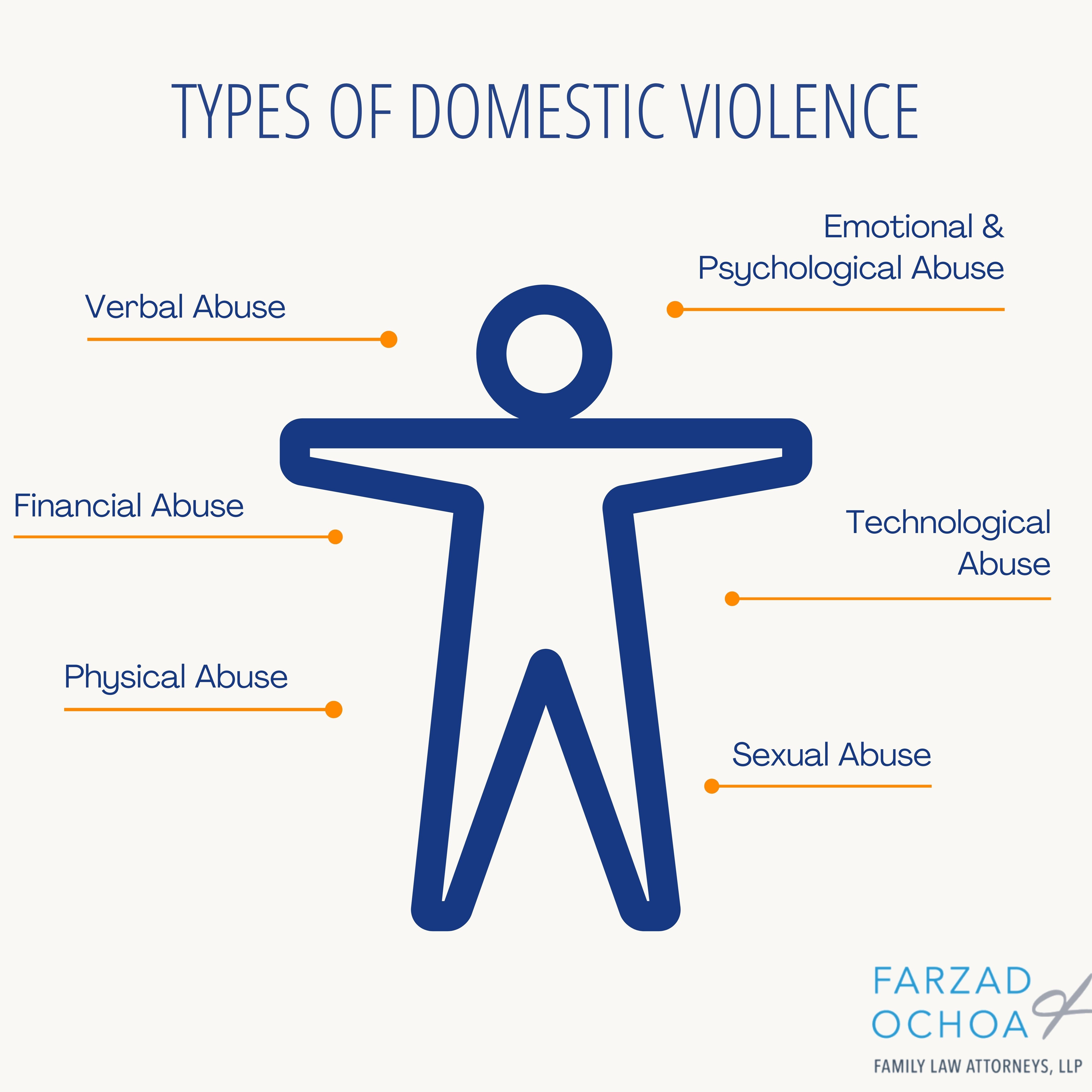
Physical domestic violence
California Family Code Section 6203 defines physical abuse as someone intentionally or recklessly causing or attempting to injure someone.
Physical also abuse includes starvation, sleep deprivation, and denial of medical treatment.
Physical abuse that does not cause pain, bruising or injury is still domestic violence.
Sexual abuse
Some abusers use sexual activity to degrade another person.
Sexual abuse includes sex trafficking, physically harming someone during sex, sabotaging a partner's birth control, and distributing explicit pictures without consent.
Non-physical domestic violence
Domestic violence includes covert forms of abuse.
1. Emotional abuse
Emotional abuse accompanies physical abuse. It includes harassment such as stalking, isolation, humiliation, and intimidation.
2. Verbal abuse
Verbally abusive relationships include derogatory statements (name-calling), degrading comments, threats, blaming, and false accusations by the abuser.
3. Financial abuse
Financial abuse includes ruining the victim's credit score, preventing them from working, and withholding money. Financial abusers exert a coercive control over spending. If married, they limit their spouse's access to money.
4. Technological abuse
California Penal Code Section 646.9(e) punishes stalking and harassment through an "electronic communication device."
Examples of technological abuse include controlling social media accounts, monitoring through G.P.S. tracking, and incessant text messaging.
What are the signs of domestic violence?
- Domestic violence is more than physical abuse. It takes several forms, such as emotional or financial abuse.
- Domestic violence is not always apparent. Warning signs in cases of physical abuse can even be subtle.
- Victims may not recognize their partners or household members are abusive or violent.
Anyone can be an abuse victim
There is no typical profile. According to the U.S. Department of Health and Human Services, domestic violence can happen between married people, people living together, and even people living apart.
There are many signs or indications of domestic violence
Whether it is physical abuse or online harassment, abusers often display a pattern of controlling behavior.
We will discuss this later in this guide, including the imbalance between the abuser and the victim.
You will learn it is all about power and control. You will recognize those dynamics underscore many patterns of abuse or violence.
An abuser's controlling behavior takes many forms
An abuser is often possessive or extremely jealous. The abuser deprives the victim of their agency or independence. They can discourage their victims from going to school, work, or visiting friends and family.
Some abusers dictate what their victims can wear or when they can use their credit cards.
Abusers spy using social media. They dictate with whom their victims can and cannot be friends on Facebook or Instagram.
Abusers often blame the victim for the abuse
- Abusers excessively criticize their victims. They unfairly blame the victim for the abusive behavior.
- Some will deliberately humiliate their partners or ex-partners in front of children, friends, or co-workers.
- Most abusers belittle, demean, and direct relentless insults at their partners.
Abusers justify their abuse
- An abuser often blames his or her victim for anything wrong that happens, no matter the cause.
- He or she will likely find an external justification for their abusive behavior, such as stress or a bad day at work.
Abusers will deny or minimize the existence or impacts of their abuse
- Between periods of abuse, they may show restraint.
- They may act charming or polite in public settings to hide the ill effects of the abusive relationship.
- They may even apologize for past abuse, promising to change their habits only to repeat the cycle of violence.
Some signs of domestic violence are more overt
These overt signs include:
- Animal cruelty, verbal threats, forced sex, and destruction of property.
- Some abusers will control access to birth control or sabotage contraceptives.
- Physical threats and attacks are a common form of domestic violence.
- Some abusers may brandish weapons or otherwise intimidate their victims.
The victim's actions or inactions show the abuse
Victims of physical abuse could display unexplained injuries, wear clothes that mask those injuries, or show sudden personality changes.
Chapter Two
Why Does Domestic Violence Happen?
How Do You Stop or Prevent Domestic Violence?
How Do You Report Domestic Violence?
Why does domestic violence happen?
Several causes of domestic violence explain but do not excuse domestic violence.
This section will discuss why abusers victimize those close to them and how society facilitates this abuse.
An abuser's demand for total control over their victim
Domestic violence is principally about the abuser's quest for power and control over their victim.
- Abusers demand a victim to prioritize their (the abuser's) feelings and emotions.
- An abusive partner's need for power may stem from their low self-esteem, jealousy, or feelings of socioeconomic or educational inadequacy.
- An abusive relationship can turn violent when the abuser feels they have lost control of the other partner.
Domestic violence abuse is a learned behavior
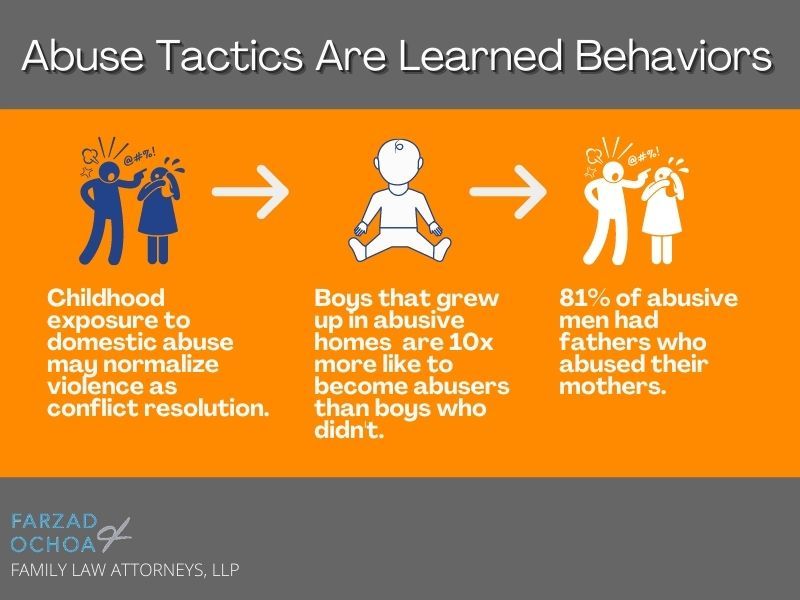
Childhood exposure to domestic abuse may normalize violence as conflict resolution.
Abusive tendencies are not inherent behaviors. An abuser often learns it from family, friends, or external sources, such as cultural influences.
- Boys that grew up in homes where domestic violence occurred are ten times more likely to become abusers than boys not exposed to domestic violence in the home.
- A shocking 81 percent of men who perpetrate domestic violence had fathers who abused their mother.
- Some abusers believe they can diminish and ultimately shatter a victim's independence.
Other factors that contribute to domestic violence
Alcohol and drugs may escalate the likelihood an abuser becomes violent.
An abuser may have difficulty regulating anger or abusive impulses due to an underlying mental health condition.
The increased stressors of COVID-19, such as stay-at-home mandates and unemployment, increased the frequency of violence in abusive relationships.
The growing number of sick people combined with strained community resources and support networks contributed to this domestic violence rise.
The pandemic has also driven a rise in gun sales, further endangering domestic abuse victims with more weapons in the home.
How do you stop or prevent domestic violence?
Reducing domestic violence is every individual's responsibility. This section will discuss individual and community efforts to support domestic violence victims.
Individually helping victims
Someone that witnesses domestic violence could intervene, but is it safe to do so? Will that place the victim at a greater risk?
The answer may be yes.
The best way to help is calling police officers trained to handle domestic violence.
It is important to speak with a victim before calling police to develop their safety plan. Victims are at risk of violence when exiting their relationship.
Community efforts to stop domestic violence
Communities could reduce domestic violence by establishing nonprofit organizations, volunteering at shelters, funding charities, and raising awareness through education.
And community members could back lawmakers that endorse victim-centered laws and policies.
How do you report domestic violence?
A safety plan must be in place before reporting domestic violence.
Please refer to our "What is a domestic violence safety plan?" section to learn more.
A victim or concerned loved one's first-choice for domestic violence reporting is law enforcement.
Calling 9-1-1 when physical or sexual violence is ongoing or imminent could prevent violence from happening or escalating.

Contacting the police
Domestic violence is a crime.
A police officer could arrest an abuser and connect a victim to additional assistance.
Calling hotlines
There are hundreds of private and public resources that use anonymous telephone helplines to assist victims.
Advocates are available 24/7 at The National Domestic Violence Hotline at 1-800-799-SAFE (7233).
Please refer to our "What are National and California domestic violence hotlines?" section for a list of local hotlines.
Contacting shelters
- Most shelters can provide short and long-term protection to domestic violence victims.
- They are staffed by advocates trained to support victims and report the abuse to authorities.
- Please refer to our "List of the top domestic violence shelters in California" for local shelter information.
Consulting with an attorney
A domestic victim could confide in a lawyer. An attorney experienced in domestic violence cases could obtain a restraining order for a victim, explain a victim's legal rights, and connect a victim to additional legal resources.
Mandated reporters
A victim could report their abuse to mandated reporters legally required to notify law enforcement or other investigators about domestic violence.
Mandated reporters could include health care providers who treat a victim that displays suspicious injuries or a school employee that suspects child abuse.
Chapter Three
Domestic Violence Statistics
Why Don't Domestic Violence Victims Leave?
What Percentage of Domestic Violence Victims are Male?
Does Domestic Violence Affect the LGBTQ+ Community?
Domestic violence statistics
The accuracy of domestic violence data is questionable because of the high rate of underreporting and misreporting.
Available data confirm the prevalence of domestic violence in California and across the country.
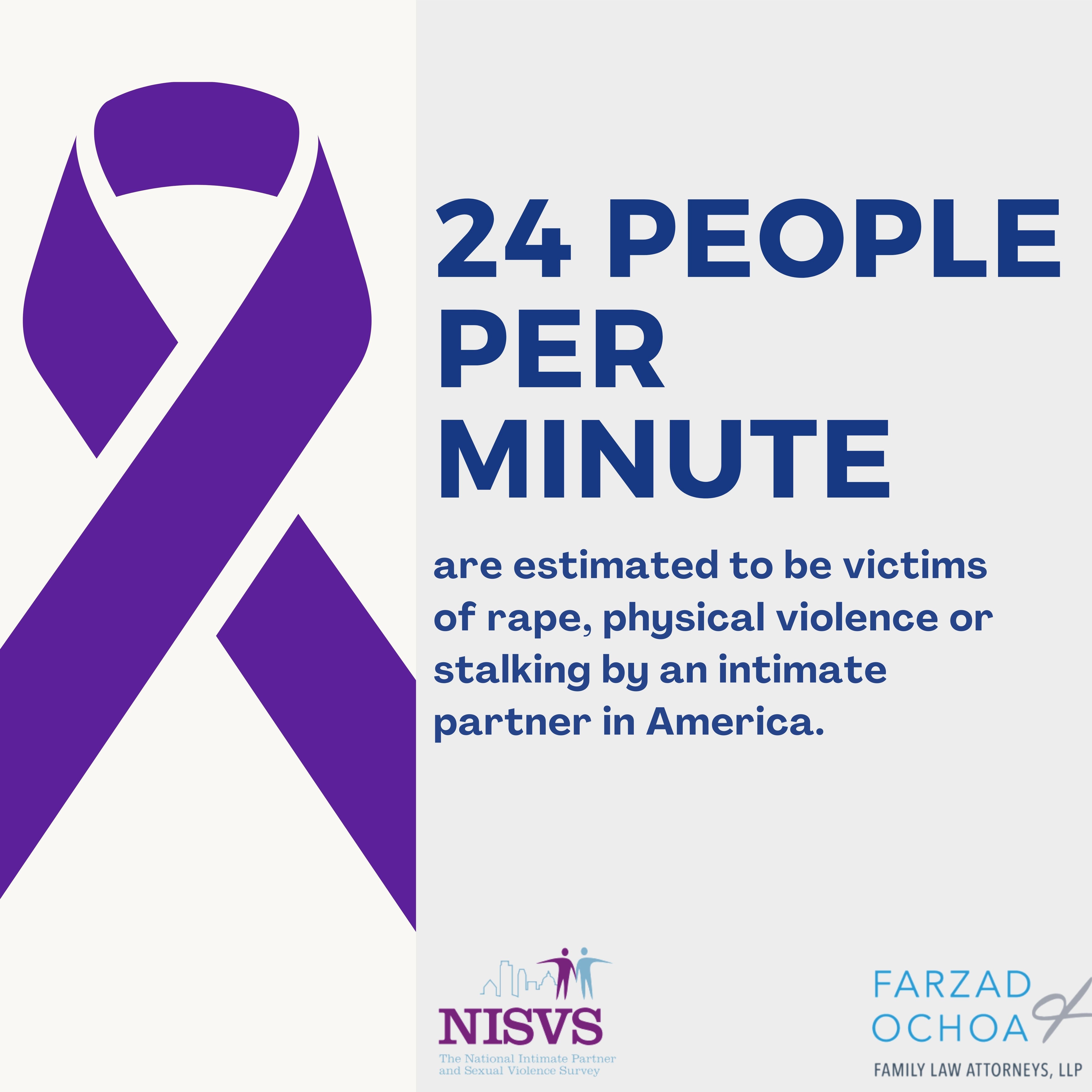
Domestic violence is a Statewide and Nationwide problem
The National Coalition Against Domestic Violence (N.C.A.D.V.) has compiled an extensive guide on domestic violence statistics.
Some of its national data points include:
- Nearly 20 people per minute are physically abused by an intimate partner in the United States.
- 1 in 10 women are raped by an intimate partner.
- Over 20,000 phone calls placed to domestic violence hotlines nationwide
- Intimate partner violence accounts for 15% of all violent crime.
- Only 34% of people injured by intimate partners receive medical care for their injuries.
- An intimate partner raped 45.4% of female victims and 29% of male victims.
- 60.8% of female stalking victims and 43.5% of men reported being stalked by a current or former intimate partner.
- Victims of intimate partner violence lose 8.0 million days of paid work each year.
Its data for California include:
- Forcible rape occurs every 56 minutes in California.
- Domestic violence shelters served almost 5,800 women and children in a single day.
- Rape crisis centers served 31,790 survivors of sexual violence between 2011 and 2012 in California alone.
- 32.9 % of California women and 27.3% of California men experience intimate partner violence.
What percentage of domestic violence cases are reported?
Only 47 percent of all domestic violence cases are reported to law enforcement. This number is even lower for specific demographics of victims.
Youth victims between 12 to 19 years of age report about one-third of domestic violence crimes.
The percentage of reporting may be lower for particular domestic violence acts, such as rape.
Almost 80 percent of all rapes go unreported.
Barriers to reporting
- Shelters, support groups, and hotlines are often not available. A lack of resources leads to isolated and unsupported victims.
- Gender-stereotyped treatment from providers and social stigma often discourages male victims from reporting.
- Many victims do not recognize their abuse, and those that do may not report because they want to protect their abuser.
- Victims such as children and elders may not speak up for themselves.
How many domestic violence cases are reported each year?
Approximately 728,000 of nonfatal domestic violence incidents are reported every year to law enforcement. These incidents include rape and aggravated assault.
How to report domestic violence anonymously
Available technology makes it possible to report domestic violence anonymously.
Here are options for the victim:
- Calling a hotline that allows callers to report domestic violence anonymously.
- Using a public phone to call for help.
- Using a law enforcement agency's option to report a crime through an email or on their website.
- Calling 9-1-1 and withholding their identity.
Why don't domestic violence victims leave?
A domestic violence victim may have several reasons for not exiting an abusive relationship.
The victim feels trapped, as if in a prison.

This section will explain common reasons domestic violence victim do not leave their abuser.
Abusers often exert power and control over their victims through fear. A victim may fear their abusive partner will carry out their threats.
Common threats an abuser makes include:
- Hurting or killing the victim.
- Hurting or killing children.
- Hurting or killing pets.
- Committing suicide.
- Taking custody of the children.
- Blocking access to financial accounts.
Barriers to escape
Victims must often overcome serious obstacles to leave their abuser safely.
Common barriers a victim faces include:
- Cultural or language barriers.
- A lack of supportive family or friends.
- Financial dependence on their abuser.
- A lack of access to assistance and resources.
- Living with a disability.
- The reluctance of law enforcement to take the abuse seriously.
- Isolation forced by the abuser.
Psychological consequences of domestic violence
The psychological effects of domestic violence could prevent a victim from cutting ties with their abuser.
Expected psychological consequences of domestic violence include:
- Low self-esteem.
- Post-traumatic stress disorder or severe anxiety.
- Rationalization of the abuse.
- Self-blaming.
- Substance abuse.
What percentage of domestic violence victims are male?
Boys and men across the country suffer domestic violence at significant rates.
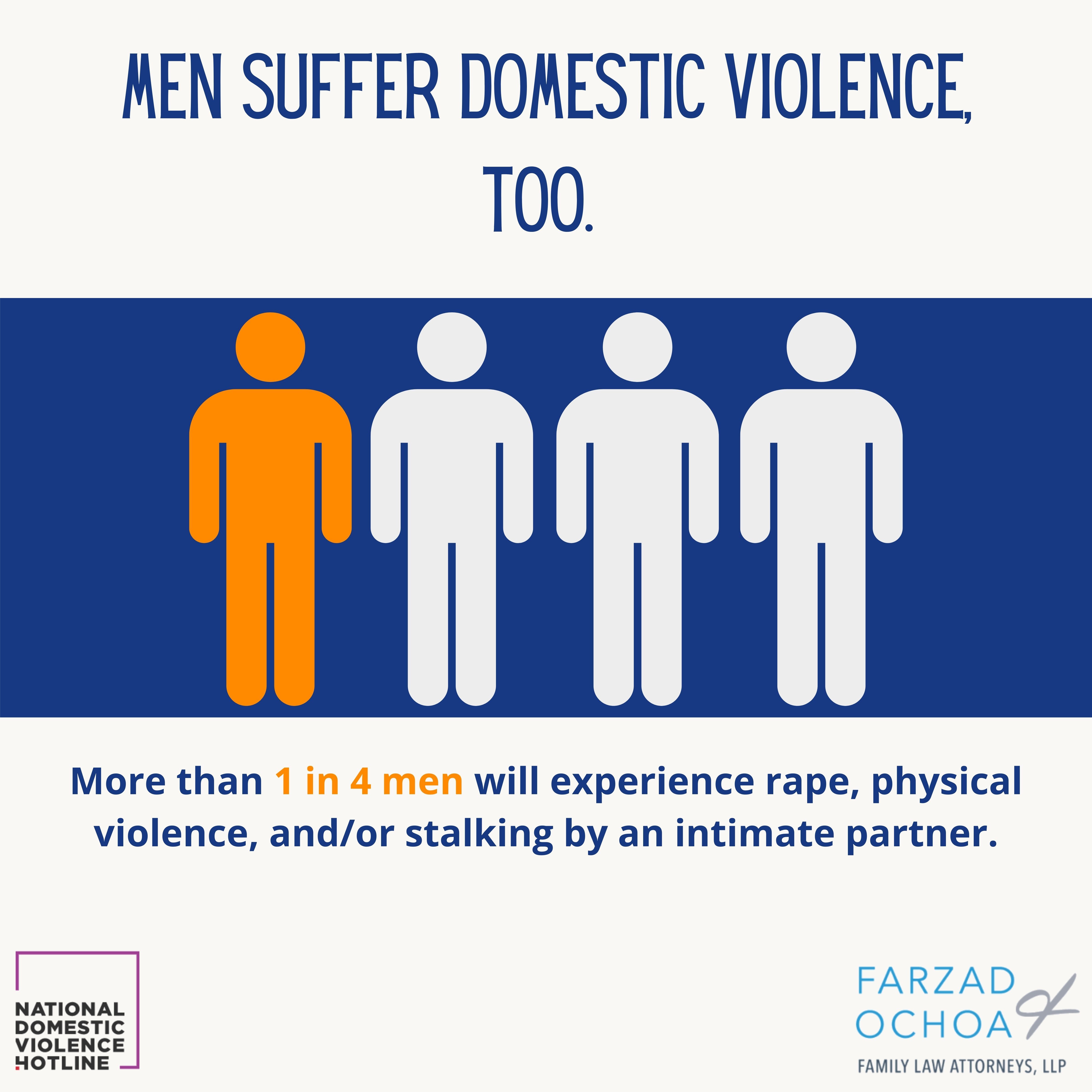
These statistics provided by the National Center for Injury Prevention and Control specify how many men suffer from domestic violence nationally:
- About 1 in 7 men ages 18 and older have experienced severe physical violence by an intimate partner.
- Almost 50 percent of all men have dealt with some psychological aggression by an intimate partner.
- An intimate partner has stalked nearly 1 in 18 men to the point the victim was scared for their life or safety or the lives or safety of loved ones.
- About 29 percent of men raped by someone they knew were violated by an intimate partner.
- Men are the victims in about six percent of murder-suicide cases in which the offender is an intimate partner.
- About 10.4 percent or approximately 11.7 million men reported having an intimate partner get or attempt to get pregnant when the male partner didn't agree to it.
Does domestic violence affect the LGBTQ+ community?
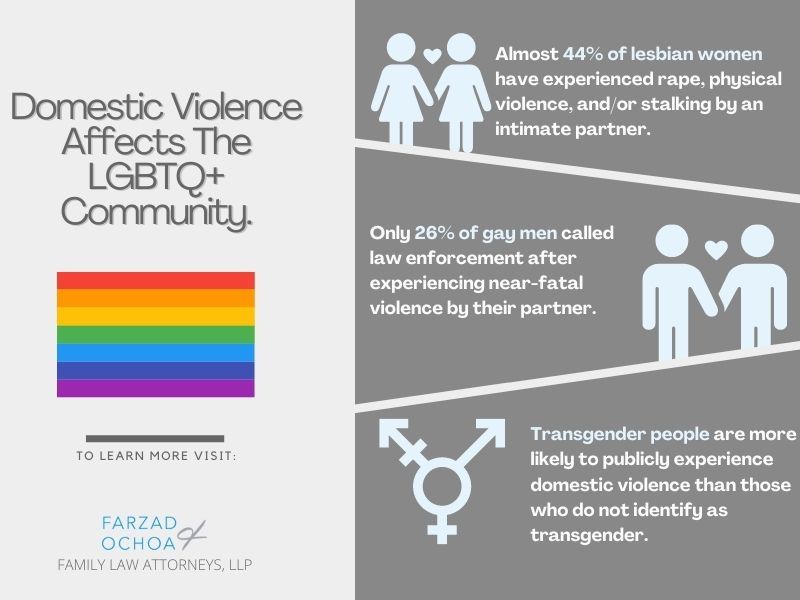
Domestic violence affects people of all gender identities and sexual orientations.
The following statistics illustrate how pervasive intimate partner violence is among LGBTQ+ couples:
- Almost 44% of lesbian women have experienced rape, physical violence, and/or stalking by an intimate partner during their lives compared to 35% of heterosexual women.
- About 26% of gay men have experienced rape, physical violence, and/or stalking by an intimate partner during their lives compared to 29% of heterosexual men.
- Bisexual people are more likely to experience sexual violence than people who do not identify as bisexual.
- Transgender people are more likely to publicly experience domestic violence than those who do not identify as transgender.
Members of the LGBTQ+ community are unlikely to report their abuse
Only 26% of gay men called law enforcement after experiencing near-fatal violence by their partner.
Less than five percent of LGBTQ+ survivors of domestic violence sought orders of protection.
Several barriers exist to seeking help for LGBTQ+ domestic violence
Some of the obstacles LGBTQ+ community members face when seeking help for intimate partner violence include:
- Societal misconceptions that domestic violence does not occur in LGBTQ+ relationships.
- Transgender victims may be denied entrance to female-only shelters.
- The risk of "outing" oneself to people they know.
- Potential mistreatment from service providers and law enforcement.
- Fear that their issues will fuel anti-LGBTQ+ feelings.
- Distrust in the legal system due to past discrimination.
Chapter Four
When Did Domestic Violence Become a Crime in the United States?
What Are the Criminal Consequences and Punishments for Domestic Violence?
Civil Damages for Domestic Violence
When did domestic violence become a crime in the United States?
Early attempts to criminalize domestic violence
States began rescinding the rights of men to beat their wives in the 1870's.
"Wife beating" was made illegal in all American states by 1920.
Domestic violence was treated as a private family matter for decades following these laws.

The Violence Against Women Act (V.A.W.A.) was a turning point
Most abusers were not punished for their abuse due to America's indifferent response to domestic violence.
A new feminist movement in the 1960's and 1970's renewed public focus on the rampant domestic and family violence.
Congress passed V.A.W.A. in 1994. This federal law improved legal and community-based responses to intimate partner violence, stalking, and sexual assault.
The Act included several measures, such as:
- Federal prosecution of interstate domestic violence crimes.
- Federal interstate enforcement for protection orders.
- Community-coordinated responses that brought together the criminal legal system, social services system, and the nonprofit sector.
What are the criminal consequences and punishments for domestic violence?
- In 2018, California had 166,890 arrests for Domestic Violence, according to the California Department of Justice.
- In 2019, the total dipped slightly to 161,123. The numbers are staggering, the reality, sobering.
What is being done to curb this disturbing rise in domestic violence, and what happens to perpetrators?
The anatomy of a criminal prosecution for domestic violence
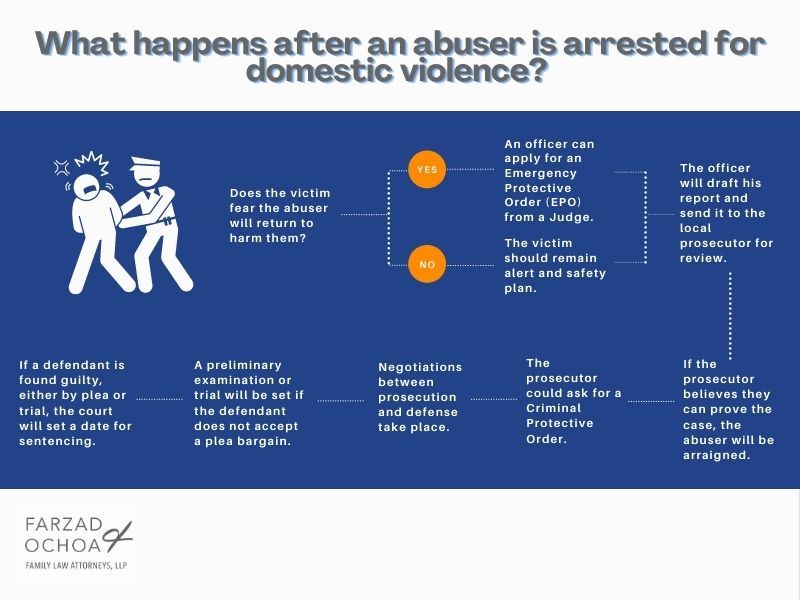
Report, investigation and/or arrest
Most Domestic violence cases originate with a call to police from a victim, witness, or even the perpetrator themselves.
- Almost every law enforcement agency in California has a policy, written or unwritten, when responding to a domestic violence call, to determine a primary aggressor and arrest that person, even if neither party wants an arrest to happen.
- Often, a victim will call just to remove the other party, or "keep the peace," but the officers will likely make an arrest if they have any evidence of violence.
- An arrest is likely to occur where any party has visible injuries, but such injuries are not required.
- Probable cause for arrest in a domestic violence incident can be as simple as non-consensual touching of another in a rude, insolent or angry manner, and need not cause injury.
"The slightest touching can be enough to commit a battery if it is done in a rude or angry way. . . The touching does not have to cause pain or injury of any kind." This is from California Criminal Jury Instructions in 2020.
Because California requires that an arrest for a misdemeanor must have been committed in the officer's presence, most domestic violence arrests are booked as felonies, causing increased bail amounts and serious repercussions for the arrestee later, whether convicted or not.
Emergency criminal protective orders
If a reporting party tells law enforcement they have a continued fear the arrestee may return and harm them, Officers can apply for an Emergency Protective Order (EPO) from a Judge at the time of a domestic violence arrest.
An officer can call a judge and present facts that establish the protected party is in fear of immediate and present danger of violence, abuse or stalking.
EPOs can be issued electronically, but only last for five court or seven calendar days.
An EPO can prohibit contact with protected parties, prevent owning possessing or receiving a firearm, and can even provide "kick out" orders prohibited the restrained party from returning home if the protected party lives there.
The defendant likely has to post bail
At the time of writing in October of 2020, California is facing another referendum to eliminate the cash bail system.
The bail schedule for each county provides for dollar amounts to be posted to secure release from jail pending court.
Most southern California counties set bail for domestic violence under California Penal Code 273.5 (corporal injury to spouse or significant other) for at least $50,000.
Bail bondsman can provide a bond for the bail amount, usually charging a premium ranging from six to ten percent of the total bail amount.
Prosecutorial review for filing
After an officer arrests a suspect for domestic violence, or completes his investigation if no arrest, he will draft his report and send it to the local prosecutor. This may be a District Attorney or City Attorney.
The prosecutor will review the case to determine if they have sufficient evidence to prove a case beyond a reasonable doubt (a high legal standard).
Independent witnesses, visible injuries, medical records and pictures documenting injuries are all considerations for filing a domestic violence case.
A victim's willingness to testify against a spouse or intimate partner may be a consideration, but ultimately the decision to file criminal charges rests solely with the prosecuting agency, and cases are routinely filed against the wishes of the victim.
Common charges for domestic violence
Domestic violence charges are defined by the relationship of the parties, but the most common charges are Penal Code 273.5(a), which is willful infliction of corporal injury on a spouse or cohabitant resulting in a traumatic condition, and 243(e)(1), battery against a spouse or cohabitant.
- 273.5(a) requires actual injury, and can be filed as a felony, carrying a maximum term of 3 years in prison without enhancements.
- 243(e)(1) requires no injury.
Other charges, such as rape, criminal threats, and disabling of a phone to prevent report of abuse can also fall under the rubric of domestic violence prosecutions.
The arraignment process
An arraignment is the initial court proceeding in any criminal case, where a defendant is advised of charges against them, and the defendant enters a plea of guilty or not guilty. The court may also address bail.
The prosecutor often asks for a Criminal Protective Order (CPO)
A CPO is issued on showing "good cause" and can order a defendant to:
- Have no contact with named victim and/or protected parties;
- Not own or possess firearms or ammunition;
- Turn in any guns in his/her possession;
- May have electronic monitoring placed on his/her person;
- Not come within a specified distance of the protected parties'
- May not dispose of or harm animals;
- Might be allowed peaceful contact ONLY for the safe exchange of children (boxes 16 a. and b. of the order)
- The victim may record the defendant; and
- The defendant may be ordered to stay away from particular locations.
CPOs are in effect the entire case, and may be incorporated as conditions of probation if/when the defendant is sentenced.
Negotiations between prosecutors and defense
Negotiations in a criminal domestic violence case typically occur after the arraignment at a future hearing variously called a felony disposition conference (FDC), a Trial Readiness Conference (TRC), or a pretrial conference (PT).
- These hearings are normally conducted in the judge's chambers if a felony, or at counsel table if a misdemeanor.
- The negotiations are not typically open for public view. The attorneys will discuss the facts, the criminal history of the defendant (if any), and potential plea agreements, called "plea bargaining."
- These matters may be continued to conduct additional discovery, the parties may confirm the matter for trial or preliminary exam, or they may resolve the case with a plea deal and enter a plea that day.
- Typically, the court will set a future date for felony sentencing, but can conduct immediate sentencing in misdemeanors at the defendant's request.
Preliminary examinations or trials
In a felony case, if a matter cannot be resolved by a plea agreement, the parties will confirm a preliminary examination date, wherein the prosecutor must introduce evidence that a crime has been committed, and the defendant is the party that committed that crime.
- There is no jury at these hearings, and the judge need find only probable cause or a strong suspicion of the truth of the charges.
- A prosecutor can have law enforcement testify as to the victim's statement at a preliminary examination, but cannot do this at trial.
- Most prosecutors prefer the victim testify at preliminary exams to familiarize them with the process and evaluate their testimony without a jury present.
Misdemeanors do not have preliminary examinations and a trial will be set if they case cannot be resolved by plea bargain or dismissal.
California affords every criminal defendant facing custody the right to a jury trial
In a domestic violence case, whether misdemeanor or felony, the prosecution will want to have the victim testify to establish their case.
A victim may be allowed a support person to accompany them on the stand. It is not uncommon for victims to be reluctant to testify and failure of a victim to testify, where there is no other independent evidence or witnesses of the crime, can cause the prosecution to dismiss a case if they cannot prove it beyond a reasonable doubt.
Prosecutors can consider the wishes of a victim about the disposition of a case, but do not represent the victim, and need not argue the position of a victim if they disagree.
Sentencing
If a defendant is found guilty, either by plea or trial, the court will set a date for sentencing.
- The defendant's counsel, the defendant, the prosecutor, and the victim typically all address the court as to their opinion of an appropriate sentence.
- The victim of a crime may address the court under Marsy's Law in California.
- A 273.5(a) charge is a "wobbler", meaning at the prosecutor's discretion, it can be filed as a misdemeanor (up to a year in jail) or felony (up to 3 years in State Prison).
- A felony fine can be up to $10,000.
- A judge or prosecutor can reduce the charge from a felony at any time both before and after a plea. A 273.5(a) charge can also be a "Strike" felony in California if there was great bodily injury, and that would prevent a reduction to a misdemeanor.
- Most felony domestic violence sentences include jail or prison terms, but imposition of jail time is not legally required.
- A 243(e)(1) sentence can carry up to a year in jail, a $1,000 fine, and is a misdemeanor.
Any conviction for domestic violence, felony or misdemeanor, where probation is granted, requires a mandatory 52-week Domestic Violence Rehabilitation Program.
Realistically, many first-offense domestic violence cases without significant injuries are resolved without jail, but do require the program. With prior convictions or injuries, prosecutors will usually seek jail or prison sentences.
The defendant may be ordered to pay up to a $5,000 payment to a battered woman's shelter and may be ordered to reimburse the victim for reasonable costs of counseling and other reasonable expenses the court finds result from the defendant's offense.
There is also a Victim Compensation Board in California that provides financial assistance to victims of violent crimes.
Immigration status
An immigrant convicted of domestic violence could lose their legal immigration status, be deported, or permanently banned from entering the United States again.
Civil damages for domestic violence
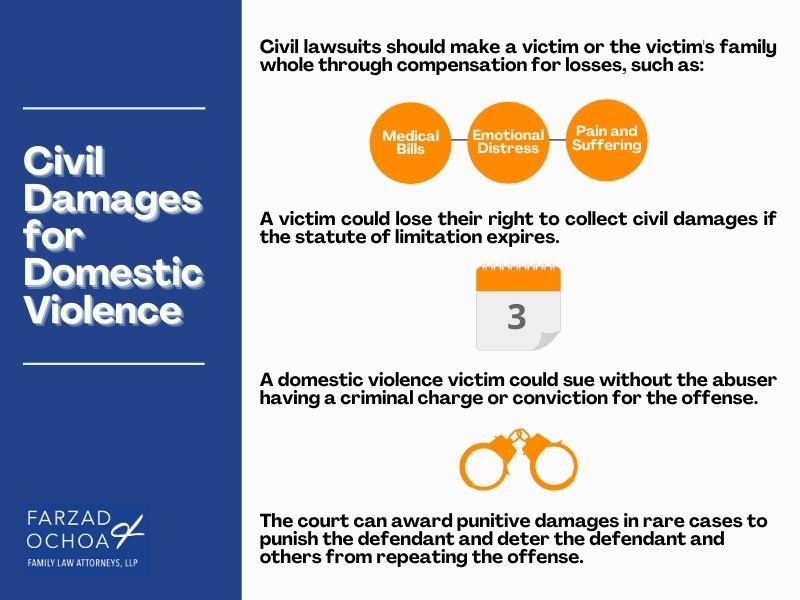
Civil lawsuits should make a victim or the victim's family whole through compensation for losses, such as pain and suffering.
A domestic violence victim could sue without the abuser having a criminal charge or conviction for the offense.
Statute of limitations
As of the date of this guide in 2020, California Code of Civil Procedure 340.15 states:
"(a) In any civil action for recovery of damages suffered as a result of domestic violence, the time for commencement of the action shall be the later of the following:
(1) Within three years from the date of the last act of domestic violence by the defendant against the plaintiff.
(2) Within three years from the date the plaintiff discovers or reasonably should have discovered that an injury or illness resulted from an act of domestic violence by the defendant against the plaintiff.
(b) As used in this section, "domestic violence" has the same meaning as defined in Section 6211 of the Family Code."
Common civil damages awarded to victims
A victim needs to prove liability by a preponderance of the evidence. That the jury believes the claim is more likely to be true than false.
A victim could collect monetary compensation to cover medical bills, emotional distress, pain and suffering and similar injuries.
Punitive damages in appropriate cases
The court imposes punitive damages to punish the defendant and deter the defendant and others from repeating the same behavior.
California Civil Code 3294 permits trial courts to award punitive damages in personal injury cases where the plaintiff proves "by clear and convincing evidence that the defendant has been guilty of oppression, fraud, or malice…" A willful act of domestic violence likely qualifies.
Chapter Five
How Do You Obtain a Domestic Violence Restraining Order?
How Does Domestic Violence Affect Child Custody?
How Does Domestic Violence Affect Alimony?
How Does Domestic Violence Affect the Division of Assets?
Are Domestic Violence Cases Public Record?
How do you obtain a domestic violence restraining order?
Domestic violence restraining orders offer protection to victims of abuse.
This section discusses the basics of a restraining order and how to obtain one.
California offers four kinds of domestic violence restraining orders:
- Emergency protective orders issued by a judge at the request of law enforcement.
- Temporary restraining orders requested by a victim that typically last between 20-25 days.
- Permanent restraining orders issuable by a judge after a hearing that last up to five years and can be renewed.
- Criminal protective orders issued by the court after criminal charges are filed against an abuser.
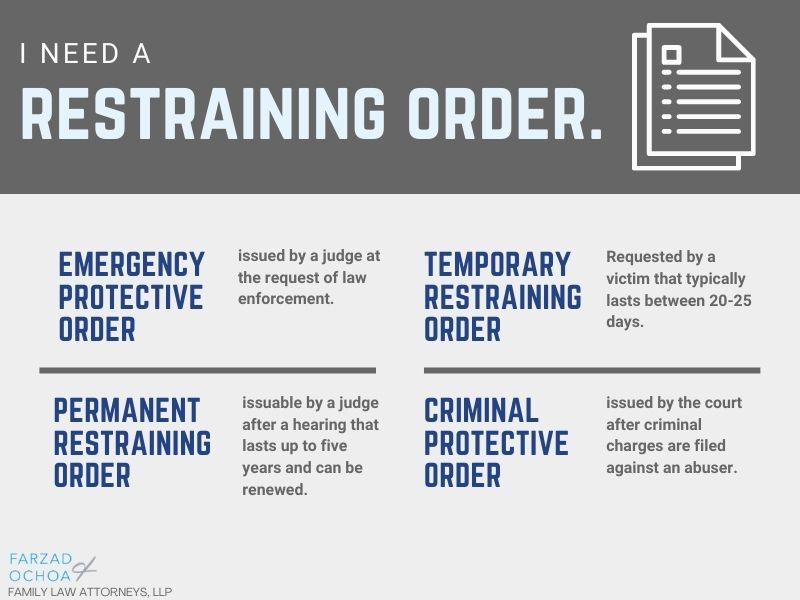
Family law domestic violence restraining orders
There are no fees associated with filing a restraining order. Any domestic violence victim, including same-sex partners and minors 12 years or older, can file for one.
Victims do not have to consult with an attorney to file; however, they often benefit from legal advice.
A domestic violence restraining order is issuable against an abuser with an intimate relationship with their victim.
These relationships are listed in the California Family Code Section 6211.
What protections does a family law domestic violence restraining order give to a victim?

Courts grant restraining orders to protect a "protected person" from abuse, harassment, stalking, or threats perpetrated by a "restrained person."
A restraining order may include a personal conduct order, stay-away order, and/or residence exclusion order.
A personal conduct order prohibits a restrained person from committing specific acts against anyone listed as a protected person in the restraining order, such as calling or destroying property as two of many examples.
Stay-away orders specify how much distance a restrained person must stay away from the protected person's residence, place of work, and other essential locations.
Residence exclusion orders require the restrained person to gather their personal belongings and move out of the protected person's residence.
These court orders can also require restrained persons to:
- Not own any firearms.
- Stay away from a protected person's pets.
- Complete a 52-week batterer's intervention program.
- Transfer phone account rights to the protected person.
- Not incur any significant expenses that harm the protected person's finances.
- Not alter insurance policies.
- Make certain payments like child support, spousal support, and bills.
- Release or return the protected person's property.
- Obey child custody and visitation orders.
A restrained person who violates a domestic violence restraining order will likely face criminal charges, jail, and fines.
Steps to filing a domestic violence restraining order
The form a victim must file depends on their case, such as whether child custody is involved.
These forms are available here.
A victim can file for a temporary restraining order for protection until the court hearing.
Serving the respondent
A victim, herself or himself, should not serve the restraining order on the restrained party.
The sheriff's department, a licensed server, or an adult not involved in the case should serve the respondent.
The victim must file proof of service before the hearing date.
What happens at a family law domestic violence restraining order hearing?
The judge hears both parties' testimony and evidence to decide whether to grant a longer restraining order. This longer order is usually three to five years.
We encourage you to read the DV-520 form which provides information about the hearing.
How does domestic violence affect child custody?
This section discusses the effect of a domestic violence finding on child custody.
Rebuttable presumption against child custody
A judge must apply a rebuttable presumption that a parent who abused a child, the other parent, or the child's siblings should not have sole or joint custody.
The abuser may rebut the presumption by certain evidence.
As we explained in our article titled, "How Does Domestic Violence Affect Child Custody?"
The Family Law Judge is required to look at the following factors in the child custody case:
- Is it in the child's best interest to give the parent joint or sole custody?
- Did the parent complete a batterer's treatment program that meets the criteria of the California Penal Code.
- If alcohol or drug use was involved, one factor is whether the parent complete an appropriate counseling program to address those issues.
- Whether the parent completed a parenting class if the Family Court determines that was appropriate.
- Whether the parent is on probation or parole, and whether he or she has complied with those terms.
- Whether the parent has complied with the restraining order terms that were issued.
- Whether there has been further domestic violence.
What about visitation?
A judge may still grant an abuser some parenting time. That parenting time depends in part on the seriousness of the abuse. In serious cases, the judge may order professionally supervised visitation.
Judges may make permanent orders consistent with emergency protective orders.
How does domestic violence affect alimony?
As we explain in our article titled, "California Spousal Support and Domestic Violence Findings," domestic violence has a significant effect on alimony. We use the word alimony and spousal support interchangeably.
From that article:
In a divorce case where a spouse has been convicted of an act of misdemeanor domestic violence against the other spouse within 5 years prior to the dissolution proceeding (typically with a petition for dissolution) being filed or any time after that, there is a "rebuttable presumption" that the convicted spouse should not receive a spousal support award.
The rules for a felony are more severe. As of 2020, Family Code 4324.5 reads in part,
(a) In any proceeding for dissolution of marriage where there is a criminal conviction for a violent sexual felony or a domestic violence felony perpetrated by one spouse against the other spouse and the petition for dissolution is filed before five years following the conviction and any time served in custody, on probation, or on parole, the following shall apply:(1) An award of spousal support to the convicted spouse from the injured spouse is prohibited…
We encourage you to read our article to learn more about alimony and domestic violence.
It may surprise you to learn a perpetrator of domestic violence need not be convicted of a crime for the court to consider the domestic violence on the issue of spousal support.
All documented evidence of any history of domestic violence between spouses is a consideration.
How does domestic violence affect the division of assets?
The same California Family Code sections that prevent domestic violence perpetrators from potentially or actually receiving spousal support also have punitive provisions regarding assets.
For a misdemeanor conviction, the court may make these orders (quoting Family Code 4325, in part):
At the request of the injured spouse, the date of separation, as defined in Section 70, shall be the date of the incident giving rise to the conviction, or earlier, if the court finds circumstances that justify an earlier date.The court may determine, based on the facts of a particular case, that the injured spouse is entitled to up to 100 percent of the community property interest in the injured spouse's retirement and pension benefits. In determining whether and how to apportion the community property interest in the retirement and pension benefits of the injured spouse, the court shall consider all of the following factors:..
That section then sets forth the factors the court should take in consideration.
Once again, a felony conviction is more severe. Quoting Family Code 4324.5, in part:
At the request of the injured spouse, the date of separation, as defined in Section 70, shall be the date of the incident giving rise to the conviction, or earlier, if the court finds circumstances that justify an earlier date.The injured spouse shall be entitled to 100 percent of the community property interest in the retirement and pension benefits of the injured spouse.
Notice the difference? A felony conviction leaves little to no room for argument by the convicted felon who committed domestic violence.
There is much more to these code sections than what we covered here. The legal advice of an experienced family law attorney is essential to understand your rights and remedies.
Are domestic violence cases public record?
Californians may access, inspect, and copy public information kept by local and state government agencies under California Constitution Article I, Section 3, subdivision (b), and the California Public Records Act.
California Rules of Court, Rule 2.400(a) permits the public to inspect court files in the clerk's office. These court files include pleadings, orders, and judgments.
All court records are presumed open unless sealed by law.
The court's right to seal domestic violence records
Domestic violence cases are generally open to the public unless they fit into a protected category or a court seals the records.
The court might seal a record in a criminal case if its release would compromise the defendant's right to a fair trial.
A judge might seal records in a civil case if one or both parties have a legitimate interest in sealing off the documents that outweigh the public interest in obtaining them.
The court must issue an order to seals documents. A person interested in accessing sealed records could try to challenge the ruling.
Chapter Six
How to Help Someone in a Domestic Violence Situation
What is a Domestic Violence Advocate?
What is a Domestic Violence Safety Plan?
What to do When Falsely Accused of Domestic Violence
How to help someone in a domestic violence situation
A concerned person could support a domestic violence victim in several ways. This section will describe how to help a person in an abusive relationship.
Considerations before helping a domestic violence victim
Please refer to the section titled, "Why don't domestic violence victims leave?" to learn more about the complexities of abusive relationships.
A steadfast supporter understands the importance of empowering a victim to make their own decisions.
Tips to help an abuse victim
- Acknowledge that the victim is in a complicated and scary situation.
- Be non-judgmental of their decisions.
- Listen empathetically.
- Encourage victims to participate in activities outside of the relationship with friends and family.
- Help them develop a safety plan.
- Encourage them to talk to advocates who can provide guidance.

The National Domestic Violence Hotline website provides additional information on how a victim to support a victim compassionately.
What is a domestic violence advocate?
A domestic violence advocate help victims limit contact with an abuser or helps the victim leave the abusive relationship.
- Advocates often affiliate with a domestic violence help center, shelter, hotline, or similar service provider.
- They are knowledgeable about the criminal justice system but do not work within the system the way police officers and prosecutors do.
Typical duties of domestic violence advocates
- Advocates offer immediate assistance to victims.
- The interventions and services an advocate provide includes:
- Educating victims about the criminal and civil legal systems.
- Helping victims request restraining orders.
- Accompany victims to court hearings.
- Creating safety plans.
- Resourcing referrals.
- Providing access to food, childcare, safe housing, and transportation.
Services domestic violence advocates do not provide
Advocates rarely do the following:
- Legally represent the client in court.
- Provide legal advice.
- Confront the abuser.
What is a domestic violence safety plan?
Safety planning is a critical step for domestic violence victims. A safety plan helps the victim safely exit their relationships.
A domestic violence plan helps victims regain control by preventing future abuse, avoiding dangerous situations, and getting to safety.
Basics of safety planning
A victim could consult with an advocate or trusted loved one to develop a safety plan.
The plan should be a custom made, and practical step-by-step guide that prepares the victim to leave his or her abusers and remain safe.
Safety plans help victims stick to a strategy during a crises when stress is high.
The National Coalition Against Domestic Violence has a list of questions to help victims prepare the safety planning process.
What to do when falsely accused of domestic violence
Innocent people are sometimes falsely accused of being a domestic violence abuser by someone motivated by revenge, an advantage in a custody battle, or other malicious reasons.
This section will discuss steps a falsely accused person can take to cope with a false accusation's consequences.
Consequences of a false accusation
A person accused of perpetrating domestic violence could feel guilty until proven innocent.
An accused abuser could lose visitation rights with their children, their employment, and their standing in the community, even without evidence or a conviction.
Immediate steps to take following a false accusation
A falsely accused person should seek legal representation immediately.
An experienced attorney may assist the falsely accused person with their defense to criminal law and/or family law actions.
Chapter Seven
What are National and California Domestic Violence Hotlines?
List of the Top Domestic Violence Shelters in California
List of the Top Domestic Violence Support Groups in California
What are National and California domestic violence hotlines?
A domestic violence victim in imminent danger should call 9-1-1.
A victim or concerned loved one could call a national or local outline to get help.
National Hotline
National Domestic Violence Hotline 1-800-799-SAFE (7233)
California Hotlines
- Su Casa - (562) 402-4888
- Human Options - (877) 854-3594
- Los Angeles County Domestic Violence Hotline - (800) 978-3600
- Jenesse Center Crisis Hotline -(800) 479-7328
- Rainbow Services - (310) 547-9343
- Coalition to Abolish Slavery & Trafficking - (888) 539-2373
- East L.A. Women's Center - (800) 585-6231
- Peace Over Violence - (310) 281-2822
- Strength United - (818) 886-0453 or (661) 253-0258
- Center for the Pacific Asian Family - (800) 339-3940
- Sojourn - (310) 264-6644
- Haven Hills - (818) 887-6589
- 1736 Family Crisis Center - (213) 745-6434
- Laura's House - (949) 498-1511
- Interval House - (562) 594-4555
- Women Transitional Living - (714) 992-1931
List of the top domestic violence shelters in California
Safe housing is often an obstacle to victims exiting an abusive relationship.
Numerous organizations around California provide housing assistance and safe spaces to domestic violence survivors.
Most shelters and safe housing programs are short-term, no-cost, confidential, and equipped to provide onsite childcare and transportation.
Below is a list of some well-known organizations a survivor could contact for help.
Southern California
- Interval House (Seal Beach) — (562) 594-4555
- Su Casa Ending Domestic Violence (Long Beach) — (562) 402-4888
- Women's Resource Center (Oceanside) — (760) 757-3500
Central California
- Haven Women's Center of Stanislaus (Modesto) — (209) 254-4331
- Stand Strong (San Luis Obispo) — (805) 781-6400
- Kings Community Action Organization (Hanford) — (877) 727-3225
Northern California
- My Sister's House (Sacramento) — (916) 428-3271
- A Safe Place (Oakland) — (510) 536-7233
- One Safe Place (Redding) — (530) 244-0117
Here is an extensive list of shelters by county.
List of the top domestic violence support groups in California
The California Partnership to End Domestic Violence maintains an extensive list of organizations providing support groups.
Below are some of the top support groups by region.
Southern California
- 1736 Family Crisis Center (Los Angeles) — (213) 745-6434
- Women's Resource Center (Oceanside) - (760) 757-3500
- Alternatives to Domestic Violence (Riverside) — (951) 683-0829
Central California
- Monterey County Rape Crisis Center (Monterey) — (831) 375-4357
- Marjaree Mason Center, Inc.(Fresno) — (559) 233-4357
- Alliance Against Family Violence and Sexual Assault (Bakersfield) — (661) 327-1091
Northern California
- DeafHope (Oakland) — (510) 735-8553
- Shelter Against Violent Environments/S.A.V.E. (Fremont) — (510) 794-6055
- The Resource Connection (San Andreas) — (209) 754-2000
Nationwide support groups
The National Center on Domestic Violence, Trauma, and Mental Health maintain a list of reputable domestic violence support groups.
Some of the top national support groups include:
- Asian Pacific Institute on Gender-Based Violence (Oakland) — (415) 568-3315
- Community United Against Violence (San Francisco) — (415) 777-5500
- National Latino Alliance for the Elimination of Domestic Violence (New York) — (646) 672-1404
Chapter Eight
Post-Traumatic Stress Disorder in Domestic Violence Victims
Effects of Domestic Violence on Children
The Role of Mental Health Therapy or Counseling in Helping Domestic Violence Victims
Post-traumatic stress disorder in domestic violence victims
Post-traumatic stress disorder (P.T.S.D.) is a common condition that affects many victims of domestic violence.
P.T.S.D. generally refers to trauma responses a person has after experiencing a highly stressful life event.
Female domestic violence victims are three times more likely to be diagnosed with P.T.S.D. than women who did not experience domestic abuse.
A trigger, such as an anniversary date or seeing someone that resembles their abuser, may evoke a memory of the past trauma.
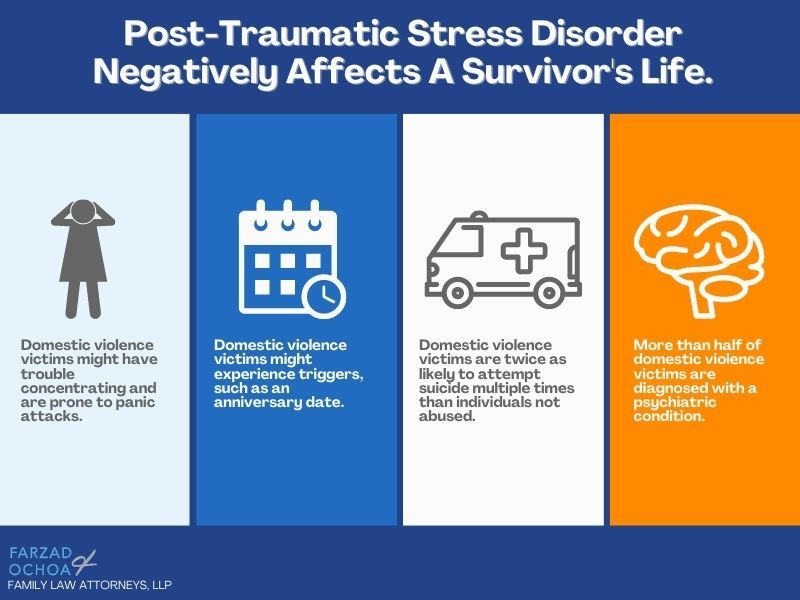
Symptoms of P.T.S.D.
Domestic violence victims may experience debilitating symptoms that affect their quality of life.
Some symptoms of P.T.S.D. include:
- Nightmares that often replay past trauma.
- A physical reaction that triggers and reminds a victim of their trauma.
- Flashbacks where a victim feels the past trauma is reoccurring.
- Extreme fear in situations like their trauma.
- Invasive, intrusive strong memories of past trauma.
P.T.S.D. negatively affects a survivor's life
Domestic violence survivors sometimes have trouble concentrating and are prone to panic attacks.
More than half of domestic violence victims are diagnosed with a psychiatric condition.
Domestic violence victims are twice as likely to attempt suicide multiple times than individuals not abused.
The American Psychiatric Association provides additional information about P.T.S.D. on its website.
Effects of domestic violence on children
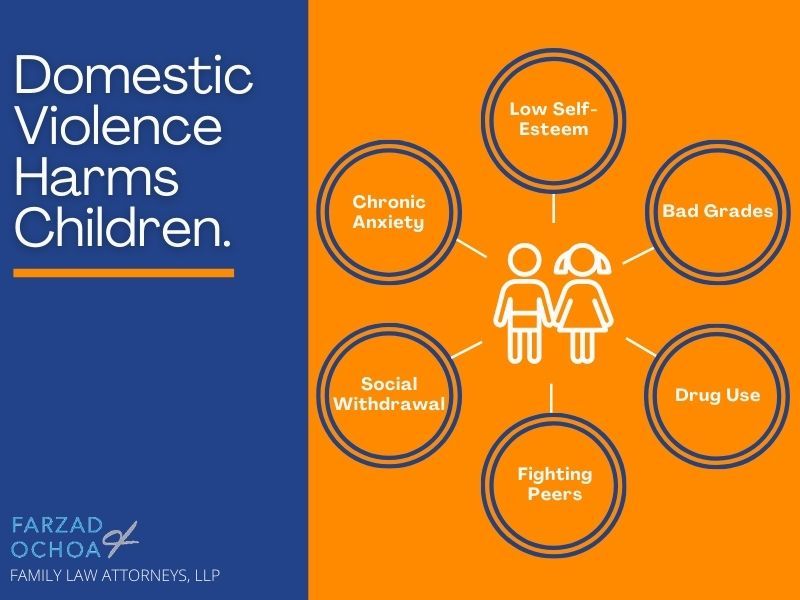
Evidence shows childhood exposure to domestic violence, such as witnessing or victimization, negatively affects child development and future adult functions.
This section will discuss the short-term and long-term effects of childhood exposure to domestic abuse.
Children typically express themselves by acting out. They do not understand or have the vocabulary to respond to domestic violence in a healthy way.
Short-term effects of domestic violence on children
Children who live inside a violent household may experience chronic anxiety in anticipation of the next abusive incident.
A preschool-aged child that witnesses or experiences domestic violence might wet the bed, suck their thumb, have nightmares, or experience separation anxiety.
A school-age child might develop low self-esteem, become less social, or suffer from stomach aches.
A teenager may skip school, experiment with drugs, or fight with peers and family members.
Long-term effects of domestic violence on children
These vulnerable children have an elevated risk of living with a mental or physical health condition, such as substance abuse or heart disease, as an adult.
They are more likely to enter an abusive relationship or abuse an intimate partner.
The role of mental health therapy or counseling in helping domestic violence victims
Mental health therapy can help domestic abuse survivors cope with the psychological and physical health consequences of abuse.
Counseling could also help a victim recognize and counteract the abuse tactics of an abuser.
Role of a counselor in empowering victims
A licensed counselor could educate abuse victims about their abuser's behaviors and help them prepare a safety plan.
And therapists are not mandatory reporters for intimate partner violence in California. Therapists must report child abuse.
This lack of mandatory reporting may help a victim open about their abuse to their therapist.
Benefits of mental health counseling
Counseling can improve a victim's mental health.
Domestic violence victims experience elevated rates of mental health conditions, such as depression, post-traumatic stress disorder, and anxiety.
Studies have found that:
- Approximately 75 percent of people who received counseling show benefit from it.
- Therapy improves emotions, behaviors, physical symptoms, and brain activity.
- Someone in therapy could experience fewer sick days, less disability and medical issues, and increased work satisfaction.
- Therapy is an effective preventive measure for suicide.
Chapter Nine
What is the National Coalition Against Domestic Violence?
What is Domestic Violence Awareness Month?
What is the Domestic Violence Ribbon?
What is the National Coalition Against Domestic Violence?
The National Coalition Against Domestic Violence (N.C.A.D.V.) is a national nonprofit headquartered in Denver that supports domestic violence victims and survivors.
It bills itself as the nation's leading grassroots voice on domestic violence.
N.C.A.D.V. established Domestic Violence Awareness Month and lobbied for the Violence Against Women Act.
Its resources page includes information about the signs of abuse, the dynamics of abuse, and why many domestic violence victims remain in abusive relationships.
N.C.A.D.V.'S Initiatives
The N.C.A.D.V. Public Policy Office partners with national organizations to support legislation and public policies that help victims.
It also backs several educational initiatives, such as an annual conference, webinars, and a speaker's bureau featuring survivors and advocates.
N.C.A.D.V. helps survivors rebuild after domestic violence through various projects, such as financial literacy education.
Online Support
Its resources page includes information about the signs of abuse, the dynamics of abuse, and why many domestic violence victims remain in abusive relationships.
N.C.A.D.V. also provides resources to help victims receive cosmetic support for any domestic-violence related injuries and safety planning.
What is Domestic Violence Awareness Month?
Domestic Violence Awareness Month is observed nationally every October. It is a time to honor those who have passed from domestic violence, raise awareness, support preventive efforts, and celebrate survivors.
It officially began in 1987 and was inspired by the National Coalition Against Domestic Violence's Day of Unity back in 1981.
Advocates and survivors across the country observe Domestic Violence Awareness Month with various events, gestures, and programming.
This includes wearing a purple ribbon, donating to a local domestic violence shelter, and writing to local representatives to support victims-centered policies.
Some domestic violence groups are adjusting their celebration plans this year due to the pandemic.
What is the Domestic Violence Ribbon?
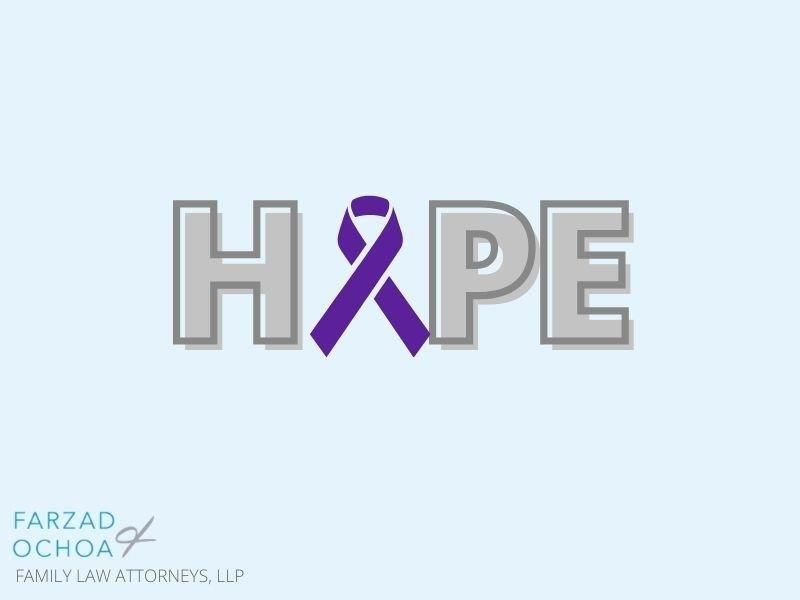
Many Americans wear a purple ribbon as a visible symbol of solidarity for domestic violence advocacy by supporters and survivors.
The purple color choice has its roots in the women's suffrage movement and National Women's party, which used purple, white, and gold during the early 1900s. Activists adopted these colors from England, where they symbolized loyalty, hope, and purity.
Many of the almost 100,000 feminists that marched in Washington, D.C. on July 9, 1978 wore lavender. They demanded gender equality.
Advocates use purple ribbons in marketing for domestic violence initiatives. These ribbons are popular during the National Domestic Violence Awareness Month in October.
The purple ribbon is a bold but straightforward gesture to honor all those affected by domestic violence.
Its widespread usage highlights how domestic violence is less taboo and taken more seriously now than in previous eras.
Chapter Ten
How Does Domestic Violence Affect the Community?
What is the Power and Control Wheel?
What is the Cycle of Domestic Violence, and How Do You Break it?
How does domestic violence affect the community?
This section describes how domestic violence negatively affects American communities.
Community costs of domestic violence
Communities nationwide spend enormously to provide domestic violence resources.
These costs include labor and financial investments from law enforcement, the judiciary, social services, school administrators, domestic violence advocates, medical personnel, and volunteers required to respond to children and families suffering from domestic violence.
One study pins the annual cost of childhood exposure to domestic violence as $55 billion to the U.S. government alone.
A national study concluded that domestic violence causes a productivity net loss annually of $1.14 billion and 7.9 million workdays.
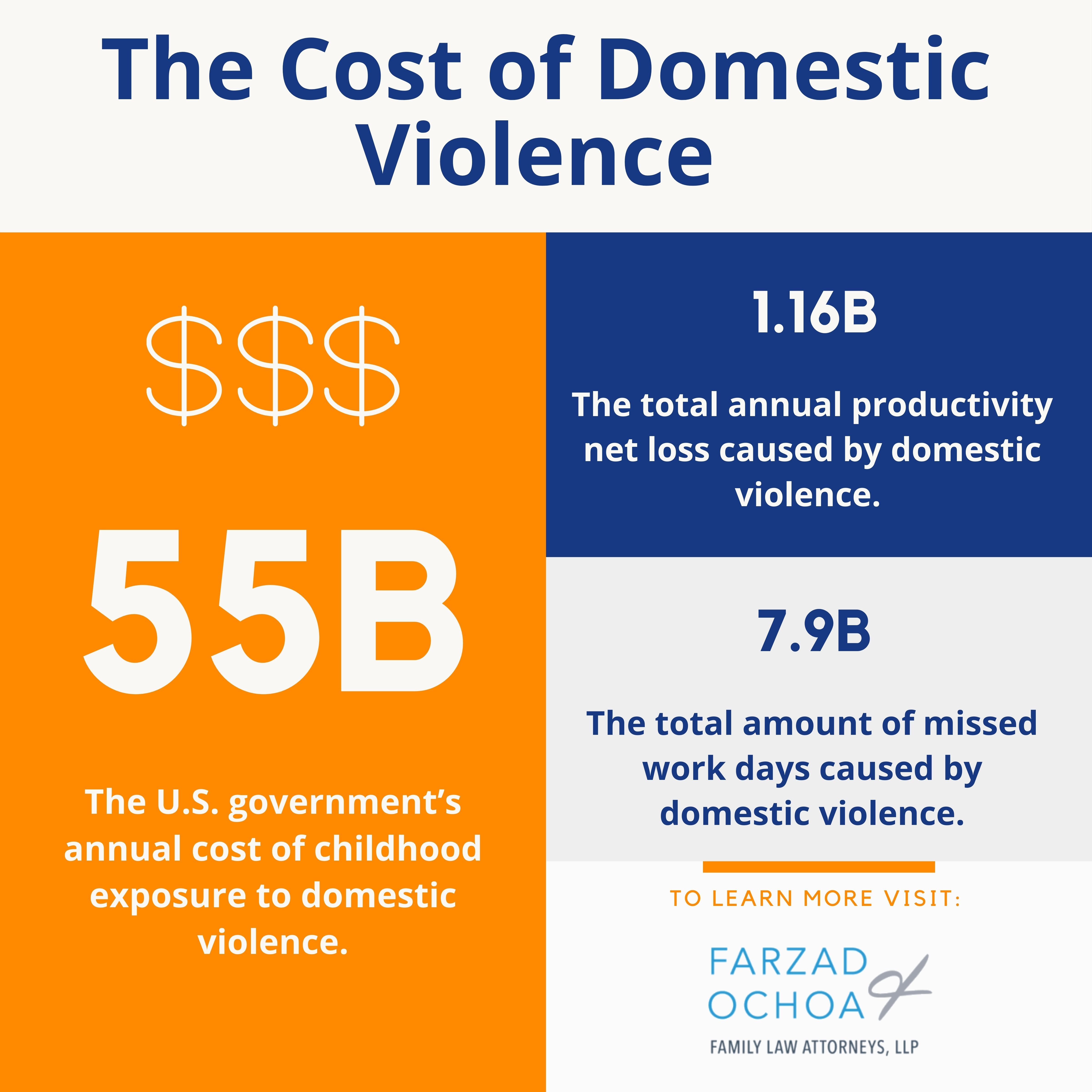
Domestic violence inflates crime rates
A community's crime rates can affect its property value, its residents' health, and push it into decay.
Domestic violence accounts for about 20% of all violent crime.
Family members, friends, neighbors, law enforcement responders, and bystanders make up 20% of domestic violence-related homicides.
Public health implications of domestic violence
Domestic violence affects the rate of disease and mental illness in many communities.
Domestic abuse correlates with a higher rate of depression and suicidal behavior.
Intimate partner violence increases a victim's risk of contracting H.I.V. or another sexually transmitted infection.
What is the Duluth Model?
The Duluth Model started as part of the Domestic Abuse Intervention Programs (DAIP) in Duluth, Minnesota.
These programs formed in 1980 to reform the criminal justice system's response to domestic violence.
Law enforcement rarely arrested domestic violence abusers at the time.
Victims had few options other than pressing criminal charges, suffering the abuse, or fleeing from their abuser.
DAIP organizers developed and proposed new domestic violence interventions for the criminal justice system to test.
The test results showed some abusers could stop abusing victims after participating in the DAIP's intervention program.
Eleven community agencies formally came together to improve batterer intervention and victim support.
This joint endeavor became known as The Duluth Model

The Duluth Model influences national and state-level policies to protect victims and provide opportunities for abusers to take accountability and change.
Research shows 68% of men who undergo The Duluth Model's program participant did not re-enter the criminal justice system over eight years.
The Duluth Model prioritizes victims' experiences when creating their curriculums and making policy recommendations to the civil and criminal justice system.
Its classes challenge abusers' beliefs about gender roles, relationships, and social norms within a respectful but critical environment.
Facilitators teach participants non-controlling and nonviolent alternatives to abuse. The Duluth Model confronts societal conditions, such as male privilege, that entitle men to use power and control tactics over women.
The mission of DAIP is to end violence against women and their families. Over 4,000 communities in all 50 states and over 26 countries have used The Duluth Model.
What is the Power and Control Wheel?
The National Center on Domestic and Sexual Violence produced and distributed the wheel starting in the 1980's to educate the public about various domestic violence forms.
The outer ring is labeled domestic and physical violence because these violent forms of abuse are reinforced by more subtle abuse.
The wheel's center is labeled "power and control" because most perpetrators use various forms of abuse to dominate their partner.
An abuser often utilizes a pattern of subtle and overt forms of abuse to maintain an imbalance of power in their favor.
A modified version of the wheel, which is our interpretation of it and in a simpler form, is below.
Here is a link to a page that explains the Power and Control Wheel in videos.

What is the cycle of domestic violence, and how do you break it?
Behaviors in a domestic violence relationship typically repeat themselves in a cycle.
This section will explain how an abuser dominates and controls their victim through a cycle of domestic violence.
There are three stages in the cycle of domestic violence
Incidents of abuse follow a period of building tension. A victim may feel like they are "walking on eggshells" around their abusive partner.
This period could last hours or months. The longer this period lasts, the more tension will build.
The tension will eventually break and result in an abusive incident. The abuse that occurs varies in form but has the same intention to dominate and control the victim.
The frequency and cruelty of domestic violence in a relationship generally increase.
An abuser might apologize, buy gifts, and act affectionately towards the victim after the abuse. The behavior is known as the honeymoon phase of the cycle.
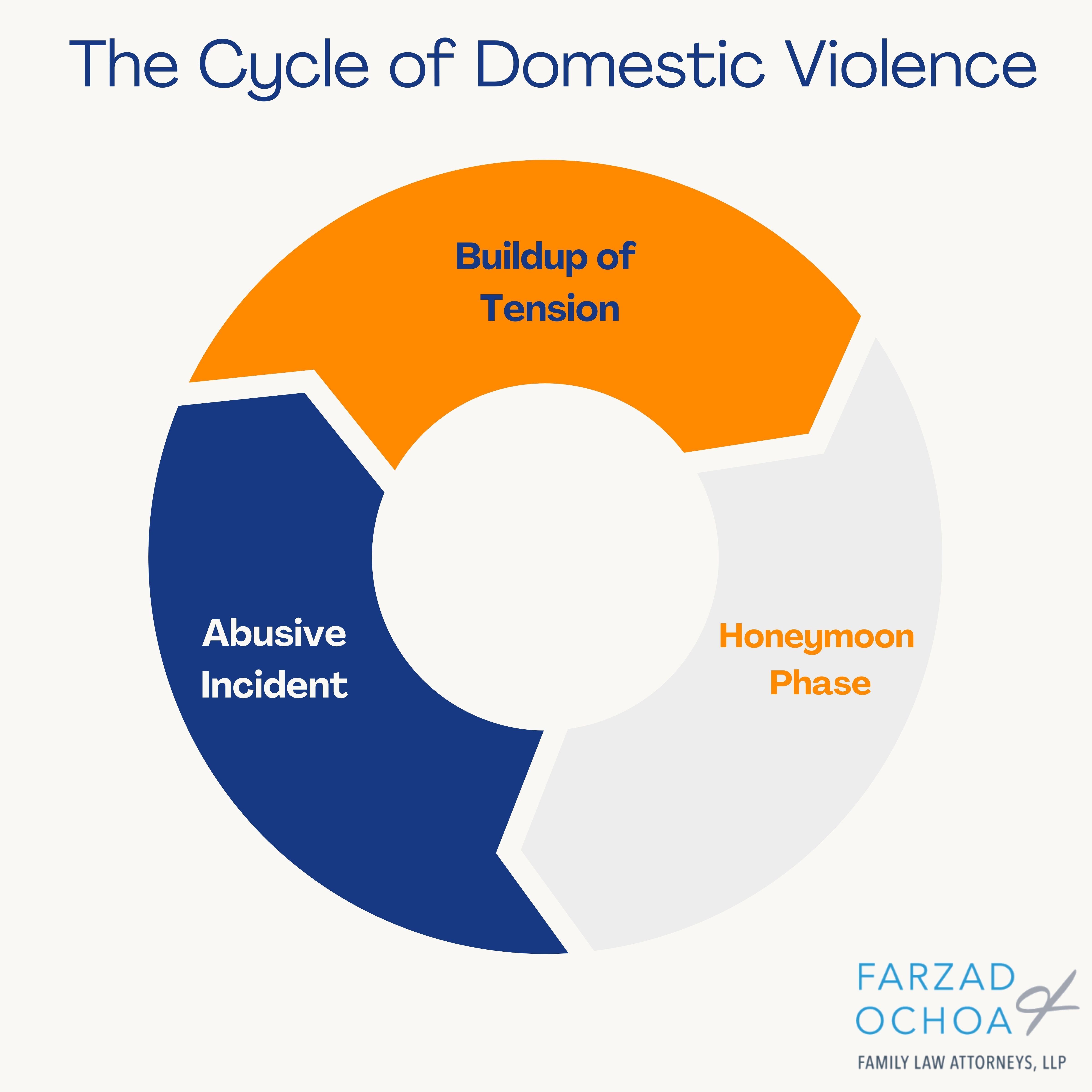
An abuser often manipulates the victim during the honeymoon phase by promising to change or stop the abuse.
A buildup of tension follows the honeymoon phase of an abusive relationship. This cycle will continue to repeat unless there is intervention.
Ending the cycle of abuse
Most abusers will not change their violent behaviors. A victim must end the relationship to stop the cycle.
A victim could develop a safety plan with a trusted loved one, therapist, or advocate to start the exiting process.
Chapter Eleven
Domestic Violence in the News
Domestic Violence Quotes
Popular Movies About Domestic Violence
Domestic violence in the news
News outlets often feature intimate partner violence. They typically involve celebrities or especially violent crimes.
Famous (or Infamous) News Stories About Domestic Violence
- Francine Hughes killed her husband in 1977 after years of suffering physical and sexual abuse. Her case led to psychological and legal communities forging the concept of Battered Woman's Syndrome.
- A former boyfriend allegedly physically abused Halle Berry in the 1990's. Halle Barry claims the alleged abuse caused her to lose 80% of her hearing in one ear permanently.
- Lorena Bobbitt was acquitted of all criminal charges in 1997 after attacking her husband with a knife. The jury found Lorena was temporarily insane due to years of domestic violence by her husband.
- Comedian Phil Hartman was murdered in Los Angeles in 1998 by his wife, who then took her own life. Their deaths followed a lengthy period of domestic violence within the marriage.
- Singer Chris Brown was charged with battery in 2009 for brutally attacking then-girlfriend Rihanna.
- The late husband of reality television star Taylor Armstrong abused her. Their turbulent marriage was documented on the show from 2010 to 2011 until he committed suicide.
- Actor Charlie Sheen pled guilty to a misdemeanor assault charge in 2010 after assaulting his wife with a knife.
- Football player Ray Rice punched and knocked his then-fiancé and later wife, Jenay Palmer, unconscious in an elevator in Atlantic City.
Domestic violence quotes

Below are uplifting quotes we cherish and hope inspires victims everywhere.
Actors
"This is not love. It is a crime. You can't look the other way just because you have not experienced domestic violence with your own flesh." — Salma Hayek
"The most important thing to know is there is a way out. That there is a way to learn how to become financially self-supporting and take care of yourself so that you can make decisions for yourself that are empowering." — Kerry Washington
"Violence against women is an appalling human rights violation. But it is not inevitable. We can put a stop to this." — Nicole Kidman
Authors
"Often it isn't the initiating trauma that creates seemingly insurmountable pain, but the lack of support after." ― S. Kelley Harrell
"You can recognize survivors of abuse by their courage. When silence is so very inviting, they step forward and share their truth so others know they aren't alone." ― Jeanne McElvaney
"The boys had always been her reason to stay, but now for the first time they were her reason to leave. She'd allowed violence to become a normal part of their life." ― Liane Moriarty
"Trauma creates change you don't choose. Healing is about creating change you do choose" — Michelle Rosenthall
Entrepreneurs
"When I am asked why she doesn't leave abuse I say… she stays because the fear of leaving is greater than the fear of staying. She will leave when the fear of staying is greater than the fear of leaving. I know this was very true for me." — Rebecca J. Burns
Popular movies about domestic violence
Below is a list of some popular films about domestic violence.
Spousal abuse
- "Sleeping with the Enemy" (1991) starring Julia Roberts.
- "Enough" (2002) starring Jennifer Lopez.
- "Tyrannosaur" (2011) starring Olivia Colman and Peter Mullan.
- "What's Love Got to Do with It" (1993) starring Angela Basset and Laurence. Fishburne as Tina and Ike Turner.
- "Cinderella" (2014) starring Cate Blanchette.
- "Big Little Lies" (2017) starring Nicole Kidman and Reese Witherspoon.
- "Madea's Family Reunion" (2000) starring Tyler Perry.
- "Dolores Claiborne" (1995) starring Kathy Bates.
Child abuse
- "Mommie Dearest" (1981) is based on actress Christina Crawford's abusive childhood.
- "Good Will Hunting" (1997) starring Matt Damon and Robin Williams.
- "The Color Purple" (1985) starring Oprah Winfrey and Whoopi Goldberg.
- "Precious" (2009) starring Gabourey Sidibe.
















